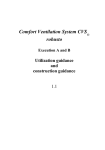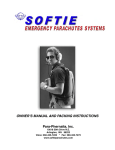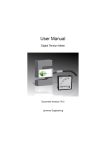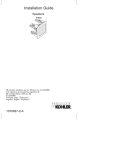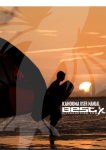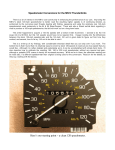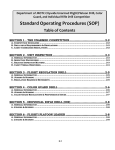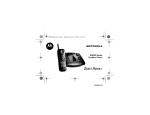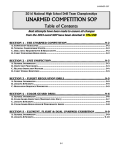Download Manual - Ocean Rodeo
Transcript
Notes Table of contents ________________________________________________ Important Notice _______________________________4 Attaching lines to wingtips______________________14 ________________________________________________ Introduction ___________________________________4 Launching with a partner _______________________16 Caution ________________________________________5 Landing the kite _______________________________17 ________________________________________________ Components ___________________________________6 Self-launching ________________________________17 ________________________________________________ Kite Specifications ______________________________7 Water relaunch________________________________18 ________________________________________________ Take a lesson!__________________________________8 Kite care and maintenance _____________________20 Kite Size for windspeed with the Stinger __________8 Strut bladder removal __________________________20 ________________________________________________ Kite Size for windspeed with the Bronco __________9 Repairing the bladder __________________________22 ________________________________________________ Assembly of kite _______________________________10 Strut bladder replacement _____________________22 ________________________________________________ Kite bar ______________________________________12 Leading edge bladder removal __________________24 Line lengths and tuning ________________________12 Leading edge bladder replacement ______________24 Unwinding your lines ___________________________13 Warranty _____________________________________26 ________________________________________________ ________________________________________________ ________________________________________________ Important Notice This is not a kitesurfing instruction manual, nor does it eliminate the necessity for obtaining professional instruction in the sport of traction kiting. The user is therefore advised to obtain such instruction as well as familiarizing him/herself with the information contained in this manual prior to flying this kite. Complete instruction may be obtained at an authorized Ocean Rodeo kite dealer. For information on lessons in your area go to www.oceanrodeo.com. Introduction Congratulations on purchasing an Ocean Rodeo kite. We trust that you will find it to be a superior product. Our kites are the result of years of passionate R&D mixed with technical expertise. Enjoy! 4 A label showing your serial number is sewn at the underside of the leading edge center strut. Important Your product must be registered with Ocean Rodeo (via our website www.oceanrodeo.com or mail in coupon found on back page of manual) to qualify for warranty. A user manual and release of liability agreement is included with each new kite. Read it. (Release liability is printed at inflation point on leading edge tube.) Replacement manuals may be obtained from the ocean rodeo website: www.oceanrodeo.com or at the address shown. If additional outfitting is required, use manufacturer’s approved materials only; do not impair or remove any safety release systems. The user of this product acknowledges both an understanding and an assumption of the risk involved in kite powered sports. Caution Safety Warning: kite powered sports can be very dangerous and physically demanding. The user of this product should understand that participating in kite powered sports may involve serious injury or death and agrees to observe the following safety precautions: • Get instruction specific to the type of kite power craft. • Obtain first aid training and carry first aid and safety/rescue devices. • Consult your physician prior to beginning kite powered sports training. • Always wear a nationally approved personal floatation device when using a kite on water. • Always wear a helmet. • Dress appropriately for weather conditions; cold water and/or cold weather can result in hypothermia. • Check your equipment prior to each use for signs of wear or failure. • Never kite alone. • Do not kite in overpowered, gusty wind conditions. • Do not kite in offshore wind conditions. • Before launching from an unfamiliar site be aware of any dangers (rocks, reefs, currents, changeable weather, etc). • Scout unfamiliar sites before launching. • Never launch from an area with any obstacles closer than 2 line lengths downwind (people, rocks, etc). • Do not kite near power lines! • Do not ask a non-kiter to assist in the launching or landing of a kite. • Do not launch kite while hooked into a harness! • Always use the kite with a functioning safety system. • Always prevent kites from inadvertently launching on land by weighting with sand, gravel, etc. • Always announce when you are going to launch your kite so people can be prepared to move in the event of a gust or a problem. • Disable an unattended kite by removing the lines, and then placing the kite leading edge down, facing the wind, and weighting with sand, gravel, etc. • Do not exceed your kiting ability; be honest with yourself. • You must not use alcohol or mind altering drugs prior to using this product. 5 Components • Backpack containing kite • Pump • Repair Kit • Kite manual • Ocean Rodeo Sticker Kite Specifications Style Size FlatArea Aspect Ratio Stinger Trainer 1.8 1.8 4.0 4 4 3.9 6 6 4.0 8 8 4.0 11 11 4.1 15 15 4.1 6 6 5.45 8 8 5.45 10 10 5.75 12 12 5.75 14 14 6.0 16 16 6.0 18 18 6.2 21 21 6.2 1.5 1.5 Stinger Pump (two sizes) Bronco 6 Ramair Trainer (m2) (AR=Span2/Area) Repair kit 7 Selecting the right size kite for the conditions, your ability and weight Take a lesson! This chart is a rough guideline. Many factors can affect your decision of which size of kite to use. Body weight, wind direction and steadiness, kiting ability, line length, etc should all be considered. When in doubt, ask someone who is capable or if there is no one to ask, it is better to err on a smaller size. Before you launch any kite, it is imperative to take certified kiteboarding lessons. For Information on lessons in your area go to www.oceanrodeo.com. Location: safe site criteria Ideal site conditions The site for your kiteboarding must meet the following criteria to ensure your safety and that of others: • No power lines within 3 line lengths (100 meters) of beach • No trees 1 line length (30 meters) from beach • Free from beach obstructions: logs, boulders, slippery seaweed, etc • Side shore wind • Smooth, steady moderate strength wind (8-15 knots) • Wide sandy beach • Shallow water close to shore • Large area of beach downwind free from obstructions • A clear bottom free of rocks, corals, excessive seaweeds, etc Organize a kitesurfing area • A take off area • A water entry area • A landing area Kite Size for windspeed with the Stinger Kite Size Skill Level Kite Size for windspeed with the Bronco 1.8 trainer 4 6 8 11 15 Kite Size Skill Level 6 8 10 12 14 16 18 21 Beginner 5-25 n/a 15-22 12-20 10-15 7-12 Beginner 12-17 10-15 n/a n/a n/a n/a n/a n/a Intermediate n/a n/a 20-27 17-25 12-20 8-15 Intermediate 17-25 15-22 13-20 11-18 9-16 8-14 n/a n/a Advanced n/a n/a n/a n/a n/a n/a Advanced 20-30+ 19-29 17-27 15-25 13-23 11-20 9-18 7-16 8 Windspeed in mph. Windspeed in mph. 9 Assembly of kite damaged if the nozzle is inserted too far. Important - When pumping up a kite for its first time, 1. Inflation: Before you inflate your kite, make sure you have a suitable “anchor” to weight down your kite (sand, fine gravel, weight bag, etc). Important - Before inserting pump nipple into bladder, make several pumps to clear nipple of any debris (sand, stones, etc) Debris in the bladder can cause small punctures. Important - Always use the largest nozzle size possible. The backdraft valve can be make sure the inner bladder is filling up all corners of the strut. If not, see strut bladder replacement section. Helpful tip: Before inserting pump nipple into bladder, make several pumps to clear nipple of any debris (sand). Sand in the bladders can cause small punctures. 2. Select an area free of obstruction, the same or larger than the span of your kite. Avoid areas with sharp objects (thorns, sharp stick, etc). 3. Starting on one wing tip, weight tip with sand and unroll kite downwind. Inflate ribs starting from upwind end, working your way downwind. Inflate ribs until they assume their shape. Do not over inflate. Because of the back draft valves, it is not required to pinch the inflate nipples to retain air pressure. Make sure plug is secure in valve and held snug with velcro closure. 4. While holding the leading edge, remove weight from wingtip. Work your way to the center of leading edge tube. Clip pump onto pump leash [5a]. Insert pump into valve labeled inflate [5b]. Ocean Rodeo kites come with a dual valve system: one to inflate and one to deflate. Inflate leading edge until kite assumes full arced shape. Do not over inflate. Note - when deflating kite, use pokers. Gently push into strut valves to release air [6]. 5. Holding kite at center of leading edge, rotate so that kite sits leading edge down and into the wind. Use a weight (sand, fine gravel, no sharp objects) and weight the leading edge of the kite. Helpful tip: We highly recommend using a bag to contain sand, fine gravel, etc for weighting the kite. This reduces your kite’s exposure to abrasion [7]. 5 10 5a 5b 6 7 11 Kite bar Line lengths and tuning Make sure your kite bar has a safety leash system that will totally depower the kite. For more information on the safety system see Ocean Rodeo kite bar manual at www.oceanrodeo.com. Kite bar length can be varied to control turn response of kite. Longer bar increases turn speed, shorter bar decreases. For bungee type leash this distance must be at least 1/2 span of kite. Leash lengths For sliding leash this distance must be at least the span of the kite from bar toline stopper. 12 All lines must be of equal length when measured from bar to end of lines. With 8a all lines equal the kite will perform well and look like picture 8a. Note wingtips are parallel. 8b If the rear lines are shorter than the fronts the kite will be prone to stalling. It would look like picture 8b. Note how wingtips angle inwards towards rear of kite. Line length can affect turning and power of kite. Optimum line lengths are 15m to 35m. Shorter lines increase kite turn response, reducing the power window of kite. Longer lines decrease turn response and increase the power window of kite. Unwinding your lines Kite lines are a very personal item. Stored incorrectly they can cause hours of frustration in tangles. Attached to the kite incorrectly, they can create a dangerous situation for you and others. Develop a line storage strategy that works for you, and do it the same way every time. Here’s what works for us: Place the loose end of your lines near the center of the leading edge tube. Unwind your lines walking upwind. Identify lines at bar end, and work your way down to kite separating lines. Before attaching any lines to kite, physically separate the left front and rear, right front and rear. Now lift your kite over the separated lines, leaving enough line length behind the kite so you do not have to drag the bar to make contact with the pigtails on the kite. Helpful tip: Stand between front lines and separate front and backs between your fingers and carefully work your way towards kite. If your lines are severely twisted, work in short segments starting near the loose end working away from the bar. Unwind lines directly into the wind stops the lines from twisting together. Always remove seaweed from lines as it dries and can cause tangles. No knots in your flying lines they create a weak point. 13 Attaching lines to wingtips Your kite has three attachment points on each wingtip, one front and two rear. Each pigtail (line coming off wingtip) has multiple knots. Before attaching your lines, consult the line attachment chart. 11a 11b 14 To connect your front lines to the kite, make a larks head in the front line and slide it on the front pigtail [11a]. Then pull the front line to tighten the larks head against the knot [11b]. Wind Range Low End High End Front C Rear D B D B E A E A D Comments Best low end, least chance of stalling kite Best overall, slow turning Best overall, fast tuning High end, quick tuning Best high end, most depower as rear lines have the least effect on kite Front Attachments a Overpowered conditions: Most depower. Most bar pressure. Sits furthest forward in wind window. Rear Attachments d Slower turning. Most bar pressure. The rear lines connect to the kite with a foolproof connector that prevents the front and back lines from being incorrectly attached. rear attachment [11f]. Note that there are Velcro pockets on the front and rear attachments where you can store unused pigtails [11g]. To join the foolproof connector to your rear line, pass the rear line through the loop of the foolproof connector [11c]. Then pass the knotted end of the connector through the loop in the rear line [11d]. Now pull tight [11e]. Larks head the foolproof connector to the e Faster turning. 11c 11d 11f 11g Least bar pressure. b Prime conditions Best overall position. Good power and depower. Best jumping. Average bar pressure. c Underpowered conditions Wake style-Least depower Kite sits back in wind window. Least bar pressure. abc d e 11e 15 Launching with a partner kite by the leading edge, the helper holds the kite sideways with lines taut slowly walking downwind until the kite is flying on the edge of the window. The pilot then slowly flies the kite up to the neutral position overhead. In preparation to launching the kite the lines should be 90 degrees to the wind direction with the leading edge facing the wind. The trim strap on the bar should be set to reduce the power during launching. Holding the Note - The kite should never be released until both people agree that the lines are correctly fastened, free of tangles and the kite is wanting to fly forwards. Self-launching When self-launching your kite, weight your wingtip in the following manner. Fold the rear end of the tip spar (rear attachment) forward to the leading edge tube to make a triangle on the wingtip. Weight this triangle with a sandbag or other weight. This technique will minimize abuse to the tip of your kite. Landing the kite It is always best to have a partner help with landing the kite. Fly the kite to the edge of the window and have your partner catch the kite by grabbing onto the leading edge. If you have no helper available you can land your kite on the water and use your safety system to fully depower the kite. Never grab the kite on trailing edge while landing, as this may send the kite back through the power zone!! 16 Assisted launch Self launch wing tip weighting 17 Water relaunch The smaller sizes relaunch with ease. The larger sizes relaunch well when using our unique launching technique. To get the kite to roll over on its back, pull hard on the bar (like you’re starting an outboard motor or lawn mower) then quickly slacken the lines by moving the bar forward and swimming towards the kite. Once the kite rolls over, steer the kite to the side of the wind window and fly it off the water. (See pictures below.) Shorten the trim strap un-hook and pull the bar quickly overhead. 18 Push the bar towards the kite quickly and lean towards the kite (swim if needed) to get the kite to roll over. Helpful tip: Depowering your kite by using your center trim strap can help the relaunch process. For those who wish to use a 5th line or a reverse launch bridle, attachment points are located on the trailing edge of the intermediate struts and on the leading edge tube. Hook back into the chicken loop. Keep the bar depowered (push out). Steer the kite to the desired side to relaunch by turning the bar Hold the bar in turned position and let the kite move to the edge of the wind window. When the kite gets to the edge of the wnd window, keep the bar depowered and fly the kite of the water. Once up, you can then reset the trim strap. Note - pulling the right side of the bar turns the kite to the left. 19 Kite care and maintenance • Keep your kite out of the sun when not in use • Deflate the leading edge and roll the kite when left on the beach to eliminate flutter damage • Dry the kite after using, as failure to do so can cause mildew and color bleeding • Rinse the kite with fresh water after extended salt water use • Check on the inside of the leading edge tube (where the body material sews on) for rocks, etc • Inspect the kite regularly for small tears, loose stitching and general wear, and have repaired as soon as possible • Beware of heat in vehicles if storing your kite with struts inflated 20 Strut bladder removal 1 Lay the kite out in a clean, non-windy area 2 Recruit a friend or get a couple of weights (sandbags, heavy books, etc) 3 Attach a line that is approximately 1.5 times as long as the strut to the valves [1] (use a larks head) 4 Push the valve inside the strut [2] 5 Have a friend hold the valve end of the strut or use a weight around the area 6 A Open the velcro at end of tube [3] B Undo velcro on white container [4] C Untuck bladder and container from the webbing loop on end of tube [5] D Pull out the bladder [6] 7 Remove the line from the valve 1 2 3 4 5 6 21 Repairing the bladder 1 Inflate the bladder 2 Cover the bladder with soapy water using a sponge or cloth 3 Look for any bubbles 4 Once the leak has been located mark it with a pen 5 Rinse the bladder with clean water and dry with a towel 6 Lightly sand the area with the sandpaper provided 7 Apply the peel and stick patch — press firmly 8 Place the bladder in a plastic bag containing talc powder and shake it until the bladder is completely covered. This will help to slide bladder back into kite. Strut bladder replacement 1 Lay the bladder out flat with the valve side up 2 Reattach the line to the valve at the 22 trailing edge of the strut [7] 3 Gently feed the front of the bladder and the valve into the strut [8] 4 Have a friend hold the trailing edge of the strut (or use a weight) while you pull the bladder back into the strut from the valve opening 5 Make sure the valve is seated properly in the opening and disconnect the line [9] 6 A Slide white bladder end container over end of bladder till there is about 3/4 of an inch of bladder extending past the end of the container [10]. B Feed container and bladder back through webbing loop on tube end [11]. C Fold container over so velcro reattaches [12]. D Tuck bladder and container back into tube [13]. E Close end cover making sure that the material flap and velcro are correctly seated [14]. 7 Partially inflate the bladder and check to make sure it is not twisted 8 Deflate the bladder and “spank” the front end by the valve to seat the bladder into the front of the strut 7 8 9 10 11 12 23 Leading edge bladder removal 1 Get two lines each approximately 2/3 the length of the leading edge tube 2 Open the velcro at the tips and gently pull a bit of the bladder out and tie the line to it [15] 3 Have a friend hold the wingtip (or use weight) 4 Gently push the two valves into the leading edge tube [16] 5 Open the zipper and gently remove the bladder [17] 6 Disconnect the lines from the bladder (see bladder repairs) and attach the lines to the velcro tab 13 15 16 17 Leading edge bladder replacement 1 Lay the bladder out valve side up and 4 Have a friend hold the middle of the leading edge by make sure there are no twists 2 Make sure the valves are correctly positioned with regards to the valve openings 3 Reattach one of the lines to one of the tips of the bladder the valve openings (or use weight) and gently pull the tube back into the leading edge 5 Repeat for the other side 6 Make sure the valves are seated properly 7 See Page 22 ‘Strut bladder replacement’ #6 14 24 25 Warranty All standard Ocean Rodeo products are covered by a One Year Warranty offered to the original purchaser on workmanship, with a One Year Warranty on materials. Warranty is limited to the repair or replacement of Ocean Rodeo product at our option. The warranty does not cover damage caused by normal wear and tear, fading, misuse or negligence, but not limited to punctures, sun exposure, seam failure due to over inflation, damage in the sun, damage caused by use in waves or shore break, and damage caused by anything other than defects in material and workmanship. This warranty is invalid if unauthorized repairs have been carried out. Repairs or alterations not covered by warranty will be billed to the customer. Factory seconds and clear out products sold at a discount carry no warranty. 26 Warranty Registration No. Name Age Sex Address City State/Province Country Postal Code/Zip Email Store Name Date of Purchase What is your product primarily used for? Male Female Kiteboarding Surfing Snowboarding Wakeboarding Landboarding Paddlesports Dealer Internet Friend Television Trade Show Magazine Ad/Article What is your other favorite sport? Skiing Hangliding Windsurfing Snowboarding Climbing Mountain Biking Why did you purchase from Ocean Rodeo? Quality Availability Fit Price Design/Style Reputation How did you hear about Ocean Rodeo? Please write any other comments or questions you may have Other Surfing Wakeboarding 27
















